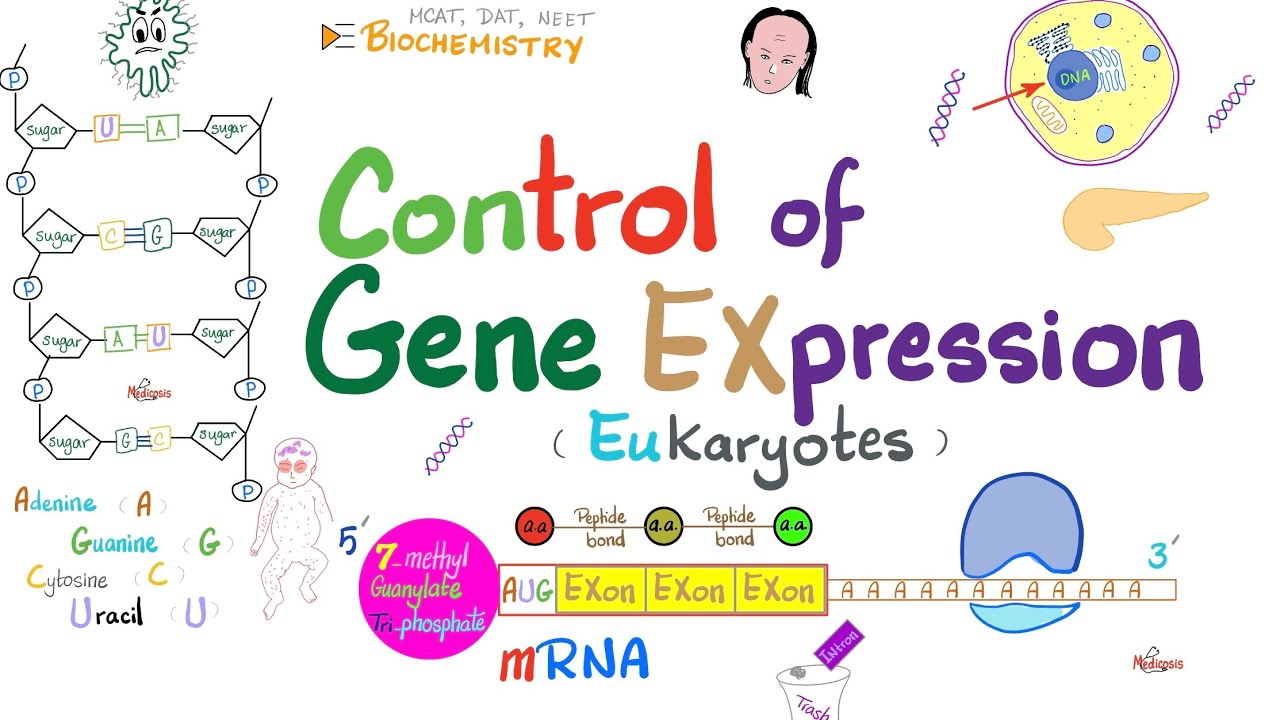Post-transcriptional regulation | Biomolecules | MCAT | Khan Academy
Summary
TLDRThis video discusses post-transcriptional regulation, a critical process in eukaryotic gene expression that occurs after DNA is transcribed into mRNA. Key steps include the splicing of introns and exons, the addition of a protective 5' cap and a 3' poly-A tail to enhance mRNA stability, and the role of RNA editing in introducing sequence variations. These modifications not only safeguard mRNA from degradation but also facilitate translation and nuclear export, with implications for understanding viral functions and gene regulation. Overall, the video offers a comprehensive look at how mRNA is processed for effective protein synthesis.
Takeaways
- 😀 Post-transcriptional regulation occurs after DNA is transcribed into mRNA and involves modifications to stabilize the mRNA.
- 😀 This process is unique to eukaryotes and helps prevent premature degradation of the mRNA before it is translated into a protein.
- 😀 DNA is transcribed into RNA one-to-one, with exons (coding sequences) retained and introns (non-coding sequences) spliced out.
- 😀 The spliceosome is responsible for splicing out introns and joining exons together to form the final mRNA.
- 😀 A simple way to remember the distinction: exons exit the nucleus, while introns stay in the nucleus.
- 😀 The mRNA receives a 5' prime cap and a 3' prime poly-A tail to protect it from degradation and help in translation.
- 😀 The 5' prime cap protects the mRNA from exonucleases and aids in ribosomal binding for translation.
- 😀 The poly-A tail, added to the 3' prime end of mRNA, increases its stability and protects it from exonucleases.
- 😀 The poly-A tail also helps with transcription termination and is built by the enzyme polyadenylate polymerase.
- 😀 RNA editing, a rarer form of regulation, can cause sequence variations in RNA molecules, including insertions, deletions, and base substitutions.
- 😀 Enzymes like ADAR and CDAR catalyze RNA editing, which can have implications for diseases by altering viral enzymes and their function.
Q & A
What is post-transcriptional regulation?
-Post-transcriptional regulation refers to the processes that occur after DNA has been transcribed into mRNA, affecting how the mRNA is processed and ultimately translated into a protein.
What happens to RNA after it is transcribed from DNA?
-After transcription, the RNA strand undergoes processing, which includes splicing out introns, adding a 5' cap, and adding a 3' poly-A tail to form a mature mRNA strand.
What are exons and introns?
-Exons are the coding sequences in the RNA that remain in the final mRNA and code for proteins, while introns are the non-coding sequences that are removed during RNA processing.
What is the role of the spliceosome?
-The spliceosome is a complex of proteins and RNA that facilitates the splicing of introns from the pre-mRNA, allowing the exons to be joined together.
What is the significance of the 5' prime cap?
-The 5' prime cap protects the mRNA from degradation by exonucleases, promotes ribosomal binding for translation, and regulates the export of mRNA from the nucleus.
What is the function of the poly-A tail?
-The poly-A tail stabilizes the mRNA, protects it from degradation, promotes translation, and aids in the termination of transcription by RNA polymerase.
How is the poly-A tail synthesized?
-The poly-A tail is synthesized through polyadenylation, where multiple adenosine monophosphates are added to the 3' end of the mRNA by the enzyme polyadenylate polymerase.
What is RNA editing, and why is it important?
-RNA editing is a process that results in sequence variation in RNA molecules, which can include insertion, deletion, and base substitution, and is important for altering protein functions, particularly in the context of infectious diseases.
What are some enzymes involved in RNA editing?
-Key enzymes involved in RNA editing include adenosine deaminase acting on RNA (ADAR), which converts adenosine to inosine, and cytidine deaminase acting on RNA (CDAR), which converts cytidine to uridine.
How does post-transcriptional regulation occur specifically in eukaryotes?
-In eukaryotes, post-transcriptional regulation involves the processing of pre-mRNA to remove introns, add protective modifications like the 5' cap and 3' poly-A tail, and prepare the mRNA for translation in the cytoplasm.
Outlines

このセクションは有料ユーザー限定です。 アクセスするには、アップグレードをお願いします。
今すぐアップグレードMindmap

このセクションは有料ユーザー限定です。 アクセスするには、アップグレードをお願いします。
今すぐアップグレードKeywords

このセクションは有料ユーザー限定です。 アクセスするには、アップグレードをお願いします。
今すぐアップグレードHighlights

このセクションは有料ユーザー限定です。 アクセスするには、アップグレードをお願いします。
今すぐアップグレードTranscripts

このセクションは有料ユーザー限定です。 アクセスするには、アップグレードをお願いします。
今すぐアップグレード関連動画をさらに表示

Regulasi Ekspresi Gen Eukariot

Modifikasi Pasca Transkripsi RNA Splicing, Pembuangan Intron

Tahapan dan Mekanisme Transkripsi DNA | Transkripsi DNA, Tahapan Awal Ekspresi Gen

Gene Expression and Regulation

Genetics - Central Dogma of Life - Lesson 17 | Don't Memorise

Control of Gene Expression | Transcription Factors, Enhancers, Promotor, Acetylation vs Methylation
5.0 / 5 (0 votes)
